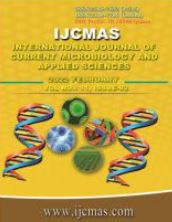


 National Academy of Agricultural Sciences (NAAS)
National Academy of Agricultural Sciences (NAAS)

|
PRINT ISSN : 2319-7692
Online ISSN : 2319-7706 Issues : 12 per year Publisher : Excellent Publishers Email : editorijcmas@gmail.com / submit@ijcmas.com Editor-in-chief: Dr.M.Prakash Index Copernicus ICV 2018: 95.39 NAAS RATING 2020: 5.38 |
Background: Dermatophytosis is a superficial clinical condition in which patients experience verities of manifestations in the skin. This disease has a high prevalence in developing countries and affects millions of people worldwide. Geographical variations, species similarities, and poor diagnosis systems are the key barriers to their therapeutic management. In this case study, we were intended to study the diagnosis and frequency distribution of dermatophytes in the Kanpur region, India. Aim and Objective: Phenotypic Identification, Diagnosis, and Isolation of Dermatophyte by using macroscopic as well as direct KOH microscopic investigation followed by culture examination. Material and Methods: This was a cross sectional case study carried out in the Department of Microbiology, RMCH&RC, for the period of about 1 year from February 2017 to May 2018. The Phenotypic identification, diagnosis, and isolation of dermatophyte by using macroscopic as well as direct KOH microscopic investigation followed by culture examination were done. A total of 300 suspected individuals were included in this study to evaluate the causative agents of dermatophytosis. Results: Out 300 suspected individuals, 144 patients were clinically diagnosed and mycologically confirmed as dermatophytes. We have isolated different species of dermatophytes of which T. mentagrophyte (56.31%) and T. rubrum (23.30%) were the most frequently observed contagious agents for humans. Further, we noted that the frequency of T. mentagrophyte (33.1%) and T. rubrum (14.56%) was higher in younger individuals as compared to children and the older population. Subsequently, we observed that T. mentagrophyte (54.37%) and T. rubrum (20.39%) were the most commonly isolated species from the skin than hair and nail. Conclusion: The prevalence of T. mentagrophyte and T. rubrum were notably higher in the Kanpur region of India. Therefore, the development of the novel, precise and rapid diagnostic tool is recommended to lead to the management and cure of dermatophytosis. Based on the above background, in this study, we have evaluated the phenotypic identification, diagnosis, and isolation of dermatophytes from suspected cases.
 |
 |
 |
 |
 |